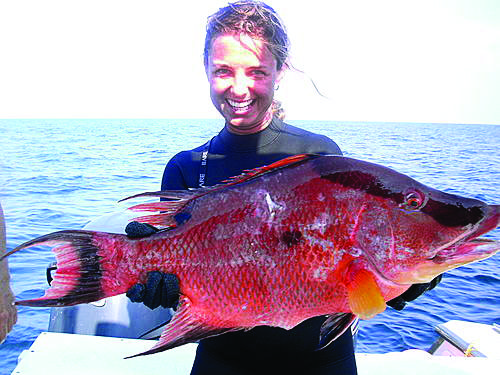By: Capt. Chad Carney
Holding a speargun on your shoulder or in front of your face.
Spearguns can kick back strong & cause severe injury. Spearguns are shot like pistols, with a straight arm & locked elbow, & maybe wrap a second hand. You can “thumb-shoot from beside the hip,” for close ups & rocked-up fish & pull the gun back to clear the muzzle.
Lack of gun familiarity before diving.
Don’t load your gun on land. Stop just an inch away so you know the bands are right. Wear spearfishing gloves & a chest pad or hip grip. Practice replacing the shaft, wrapping the line & pull test that the mechanism is locked. Keep your hands outside of the line wraps and never in-between them.
Leaving the safety on.
Safeties are before hunting. Underwater point the gun only at your target. Fish are gone in a flash when you choke the shot.
Too much gear slows you down.
Keep equipment simple. Long fins and streamlined dive gear. Scuba with freeshafts or a short bungee & fixed line. Watch your gas level. A reel or float-line is more common for freedivers.
Not starting out by shooting small bottom fish.
Big powerful fish can break gear & hurt you. Master techniques & equipment on small legal-size fish, i.e., hogfish.
Short underpowered spearguns, Hawaiian slings or polespears.
The saying goes “Big fish, big spear!” Water density slows short & underpowered spears. A longer spear has the best range and impact for the habitat you hunt.

The best shot is often in the descent. Experienced shooters load while descending and polespear or Hawaiian sling spearos ready to pull back and fire.
Swimming near the bottom.
Get high and drop silently on fish. It relieves pressure on fish, and gravity speeds the shot & pins a fish to the bottom. Jerky movement and chasing fish are fish spookers, so slow down, relax and blend into the underwater environment.
Fish ID.
Go to my fwc.com & learn shapes, markings, skin appearance of prey.
Shooting undersized fish. Learn size regulations and check often.
Don’t shoot marginal fish. Be sure you’re proud of all fish you shoot.
Shooting from too far away.
Learn the flight distance of fish. Hogfish allow close shots, but snappers and groupers are spooky.
Target shooting.
Spearguns, Hawaiian slings and polespears need repeated in water firing from various angles/distances. Think about a shot & you’ll miss it. I shoot flattened aluminum cans or what’s on the bottom. Try dropping cans & shooting as they sink.
Letting a sling or speargun drift away after shooting.
Hawaiian slings, free shaft guns, bluewater guns or riding rig guns can easily float away while a diver is busy. Loop a buoyant sling or gun over your arm after a shot.
Pulling on a speared fish
A spear will often tear free. Swim to the fish and keep it pinned, while knifing it. Dragging wounded fish to the surface is risky so have a buddy back up.
Spear removal before stringing the fish
Almost always is a lost fish. String it first, kill it second.
Bagging fish is difficult to do & wastes time. It creates huge drag & doesn’t conceal fish from predators.
Not having a small narrow beam dive light
A spot beam light can shoot in dark holes, but a diver w/o a light can’t nor pursue wounded fish in dimly lighted areas.
Captain Chad Carney – Diving Instructor & Journalist
mobile: 727-423-7775
e-mail: chad.carney@yahoo.com
www.floridaskindiver.com/spearfishingphotos
www.deeperblue.com/beginners-guide-spearfishing
